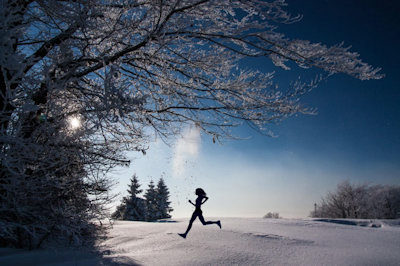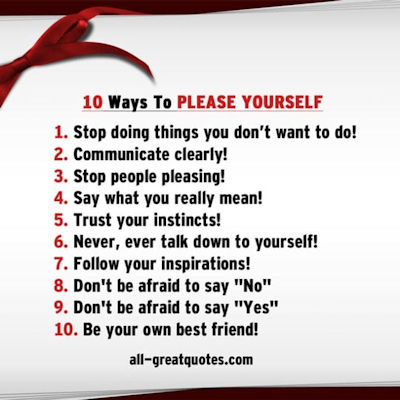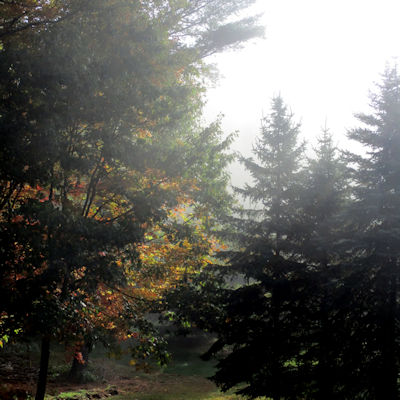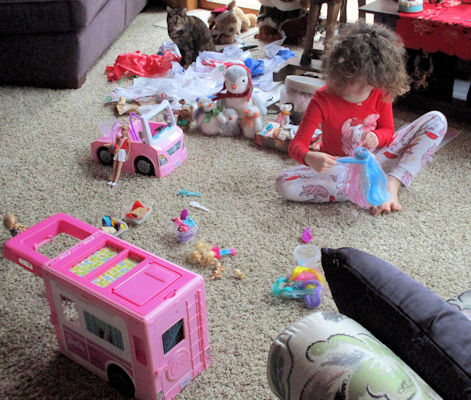Who Do You Envy? (Daily Prompt: Mon. Dec. 12, 2022)
Envy materializes when one wants something somebody else has, while jealousy is the feeling that a relationship is being threatened
Brene Brown
I imagine most people will answer today’s prompt by saying they envy those who are famous and/or wealthy, who have perfect romantic relationships and/or myriad lifelong friendships, whose children are well behaved and/or uber-successful, who live in giant McMansions with live-in household staff, who are thin and/or beautiful or handsome, who don’t need to work or have a job that satisfies them and pays well … You get the picture. Most people envy those who have something “more” than what they have and are happier (or appear so) all around.
Not me. I have “enough”. I don’t need fame or fortune, my relationship with my husband is great, I have several friends I can depend on in a pinch, my kids are happy and healthy and have never been arrested, I’m living in my dream house in the country with a live-in cat (who, admittedly, does NOT do household chores, but who provides endless entertainment and companionship), I’m still relatively thin, I’m retired from a job I loved but no longer miss, I keep busy doing things I enjoy … (Now that I think about it, there might be some people out there who envy ME!)
I do admit, however, to having a spot of envy for people who love to exercise outdoors in the worst weather. Walking, hiking, jogging, skiing (downhill or cross-country), snowshoeing … any or all of the above seem like wonderful ways to spend the cold winter months in southern Ontario. And while I am well aware of the benefits of getting “out and about” in all kinds of weather – for both my physical and mental well-being – the idea of pulling on wind pants and a heavy coat, layering on scarves, hats, mitts, and boots, and trudging off through the snow makes me, quite honestly, want to rush back to bed and pull the covers over my head. It’s just too much effort. (I honestly think that in a former life I was some kind of animal that hibernated through the winter – maybe a bear or a chipmunk or a hedgehog).
I have also always been envious of those who undertake hearty fair weather outdoor activities with gusto. There’s a man who runs past our house on a regular basis (good weather and bad), dressed in spandex leggings and a turtleneck with a reflective vest over top (out here you don’t venture out during certain times of the year without your reflective vest on – for fear of being mistaken for a deer or wild turkey and getting shot). He always seems quite happy about what he’s doing (he waves if we’re outside and he always has a smile on his face). From the look of things, he’s around the same age as me (on “the other side of 55”), so he’s no “spring chicken”. He lives on the corner of the street our property butts up against, across from the end of the next road parallel to ours (I’ve seen him coming out of his driveway occasionally as I’ve been driving past). He may take different routes now and again, but he regularly runs around our “block” (usually going south from his house, then west on the next intersecting road, north on our street, around the corner and east towards home). That might not seem like a big deal to urban dwellers, but our rural “block” is 5 kilometres in length (just over 3 miles for U.S. readers). That’s about the same length as the infamous Nuerburgring race track in Germany (only rectangular in shape). My husband and I have walked it a few times (each “corner-to-corner street” is 1.25 km long; it takes around 45 minutes to do the circuit. It’s also uphill in two of the four directions!) Walking it occasionally is an entertaining (albeit challenging) endeavour; the idea of RUNNING it is unfathomable to me (but I envy my neighbour’s ability to do it on a regular basis).

When I lived in more urban areas (pre-retirement) I would regularly see people of various ages running (or jogging – I’m not entirely sure of the difference) through our neighbourhood, or down along the lakefront path where I would occasionally walk. They were almost always dressed in nifty spandex outfits, with headphones in their ears, iPods strapped to their arms, and fanny packs around their waists holding bottles of water and whatever other supplies they might need (probably things like Polysporin and bandaids). I would occasionally look at them and think, “I could do that if I wanted to.” And I probably could have – I just didn’t want to! I never really “got” it. I mean, if a bear or a flock of angry Canada geese was chasing me, I might pick up my pace (from my comfortable 2.5 mile per hour saunter to a 3 or 4 mph jog), but I can’t imagine maintaining it for more than a minute or two. Neither my lungs nor my legs could take it. I’m just not built for speed (physically or mentally), I guess.
I fully understand how important regular exercise is. And I enjoy a morning yoga routine, mixed in with some mild strength training. I’m a keen gardener (logging anywhere from three to six hours a day of digging, weeding, planting, etc. during the warm weather), and my husband and I often walk “to the corner and back” (either north or south; each a moderately brisk 2.5 km [1.5 mile] journey), but we generally only go out when the weather is fine, and the roads are clear of ice and snow (there are no sidewalks out here!) We always say we “should get out more”, but somehow we never do – “other things” always seem to get in the way.
I wish I was more like the die-hard exercise enthusiasts who go to the gym regularly, run, jog, or hike for miles and miles and miles, in all kinds of weather, or who engage in other robust outdoor activities (biking, rowing, tennis, etc.) – but it’s just not me. Every winter I promise myself I’ll try harder … but there’s always one reason (excuse) or another that lets me off the hook. I envy them their motivation and their stamina. But it’s just not me.
Maybe next year …
Daily Prompt: Monday, December 5, 2022
What is one thing you would change about yourself?
This is the kind of question often asked at job interviews or performance assessments. Of course, back when I was actively seeking work (or looking to change jobs, or take on more responsibility at the institution where I was working, or impress the boss), I’d generally provide one of the standard expected answers (“To be a better employee”, “To work harder and smarter”, “To be more helpful”, etc.) rather than ‘the truth, the whole truth, and nothing but the truth’ (“To stop trying to hard so impress other people”, “To stop worrying about what other people think of me”, “To learn to say ‘No’ more often”.)
But now? I’m not trying to impress anyone anymore; there’s no need. I’m happily retired and enjoying doing what I want to do, when and how I want to do it, for and with people I respect. However … that old desire to please others, to be judged worthy (of what? who knows!), to satisfy the wants and needs of others over my own – those instincts are still alive and kicking inside me. And THAT is the one thing I would change about myself.
Being a ‘people pleaser’ isn’t necessarily a BAD thing, unless it becomes your default response. When I look back over my more than half a century of being a daughter, a sister, an aunt, a student, an employee, a teacher, a wife, a mother, a grandmother, a friend, a mentor … I’m shocked at how often I’ve done things for others vs. for my own self, and how my health (mental and physical) has often suffered as a result (especially when it comes to family relationships).
Since retiring, I have undertaken a great deal of self-reflection, learned to meditate, and started engaging in physical activities that energize me. I regularly vow to put myself first (even if I don’t always quite manage!) I’m getting better at it, though – even if I backslide now and then. Some habits, it seems (especially when honed over 60+ years) are very hard to break.
But I’m working on it!
CHRISTMAS TRADITIONS (2021 Edition): The ‘One Thing’ Rule
“How am I supposed to pick just one?” my not-quite-seven-year-old granddaughter grumbled as she turned the page of the Amazon Kids catalogue she was studying. She was lying on her stomach, knees bent, feet scissoring back and forth as she held a ballpoint pen with a pink pompom on top in her hand, ready to circle the next must-have item that caught her eye.
“There are so many toys I want for Christmas,” she sighed, casting a soulful look my way. “But Dad says I can only ask Santa for one thing!”
I smiled back, but didn’t reply. I agreed with her Dad. Because that’s the way I’d raised him. He and his brother never went ‘without’ on Christmas morning. In fact, our family room was generally so jam-packed with gifts on December 25 it was difficult to make your way across the room without having to step over various Lego sets, a Hot Wheels track, and a number of actions figures of one type or another. But only one of those many gifts for each boy had come from Santa.
Why? Quite simply, it was because that was how I (and my siblings) had been raised during the 1950s and 1960s, when money was tight and kids didn’t get every single thing they wanted for Christmas. And while Christmas had become a far more avaricious and commercialized holiday by the 1980s, and my generation had a lot more money to spend (and a whole lot more places to spend it), I didn’t want the boys to expect Santa to provide them with every toy their little hearts desired. So the ‘one item from Santa’ rule I’d grown up with was implemented right from the get-go.
As I sat there on the floor beside my granddaughter, watching her go through the catalogue, circling the occasional item, asking me to help her read the descriptions under some of the pictures, I found myself drifting back to the Christmas when I was seven.
~~~
“I don’t know whether to ask Santa for the bride doll or the ballerina,” I said to my nine-and-a-half-year-old sister Sharon, pointing to the page filled with photos of seventeen-inch ‘fashion dolls’ in the Eaton’s Christmas Catalogue. It was a Saturday or Sunday morning in late November, 1960. We were studying the glossy pages of the book with the same level of concentration my granddaughter had exhibited for her own modern-day catalogue.
“The bride doll has a …” I squinted at the strange word.
“True-so”, Sharon sounded it out. I had no idea what it meant, but there were a lot of clothes in the photo.
“The ballerina has bendable arms and legs,” I declared, moving my finger slightly to a doll posed in a pirouette. She was wearing a frilly black and white tutu and pink tights. “And she’s got real ballet slippers on!” I added.
“She doesn’t have as many clothes, though,” Sharon said.
“I know,” I replied. “But she’s really really pretty.” I’d never seen a doll with completely bend-able arms and legs before. Most had legs that went into a huge ‘V’ when you sat them down, and arms that stuck out to the sides when you tried to dress and undress them.
Except for Barbie® , of course. Her legs went straight out when you sat her down – but they didn’t bend. And her arms were pretty stiff. The ballerina doll – although much larger than Barbie® – could be posed!
“I’m going to ask for another Barbie,” Sharon announced, as if reading my mind. She turned the page to reveal the huge range of Barbie® dolls and accessories on offer. We already each had a Barbie® (blonde for her, brunette for me) and several outfits, but the ads on television had Sharon pretty much convinced that her life wouldn’t be complete until she had a whole lot more!
“Maybe I’ll ask for a Ken, too”, she murmured.
“That’s two things,” I told her. “You can only ask Santa for one.”
Sharon tapped her finger on the ‘Barbie and Ken Sun and Fun Gift Set’ positioned smack-dab in the middle of the page. “If I ask for this, I get both a Barbie and a Ken,” she announced. “And they’re dressed in their bathing suits, but they’ve got two outfits each. A tennis one and a …” She paused as she read the description to herself before finishing, “An after-hours outfit for everyday casual wear.”
I was impressed. She had it all figured out. Of course, she had a couple more Christmases under her belt than I did, so she had the ‘one thing from Santa’ rule well under control. I was still learning.
When we visited Santa at Eaton’s Toyland in downtown Toronto a week later, Sharon did indeed ask for the Sun and Fun Gift Set. I’d settled on the ballerina doll (it really wasn’t much of a contest; Sharon already had a 17” bride doll that I could play with if I wanted to). Our little brother Bobby (who was only two-and-a-half) asked for a truck (although he was kind of reluctant to talk to the strange man with the white beard and red suit who kept asking him if he’d been ‘a good little boy this year’; that was a loaded question where Bobby was concerned!)
On Christmas morning we found just what we’d asked for waiting for us in the living room, right next to the Christmas tree. And while there were other presents wrapped and under the tree (from our parents and the two grandmothers who lived upstairs), we never expected or received an inordinate amount of ‘stuff’ for that Christmas, or any other. We were just grateful for what we did get – especially that ‘one special thing’ from Santa.
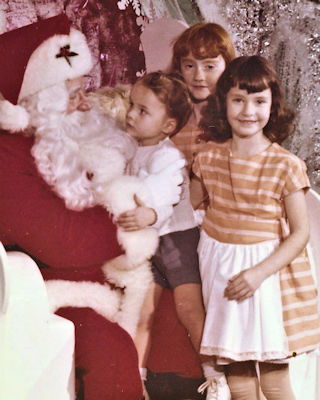

~~~
“I bet Dad got lots of things from Santa when he was my age.”
My granddaughter’s voice pulled me out of 1960 and back to the present.
“No,” I answered honestly. “He got a lot of stuff, but only one thing from Santa. Just like you.”
She sat up, swivelling around to face me and crossing her legs effortlessly as she asked, “What did he ask for when he was my age?”
I tried to recall the Christmas her Dad was six. My memories of specific Christmases during the eighties are a bit of a blur, and I couldn’t quite focus on 1987.
“I can’t remember,” I admitted. “Probably a Transformer of some kind.”
She rolled her eyes. Her Dad has a whole wall of shelves in his at-home office jam-packed with his collection of transformable robot vehicles. He’d been a collector from the age of five.
“But I do remember the year he was three and a half,” I told her. “He’d seen a wooden train set at the mall and immediately set his mind to asking Santa for it that year.”
~~~
“A train with a wooden track eh?” Santa said, running his hand down his long white beard. “I don’t think I’ve had anyone ask for one of those this year.”
He was crouched down in front of my son, who was dressed in his blue and white Cookie Monster snowsuit, his favourite toque pulled down so low it nearly covered his eyes. It was a frigidly cold December day in 1984 and we were in front of The Christmas Place in Grand Bend, Ontario, the town my parents had moved to in 1981. Santa made special guest appearances outside the store on weekends during December, waving to passersby and talking to children who stopped to sit beside him in his sleigh and make their annual gift requests.
My son, that day, had refused to get into the sleigh, convinced for some reason that Santa’s reindeer would magically appear and fly off while he was still sitting on the front seat with Santa. So Santa came down to talk to him face-to-face.
“I think we can do that. Is there anything else you want?” Santa asked.
My son looked over at me, confusion clear on his little face.
“He knows he’s only allowed to ask for one thing from you,” I explained to Santa with a smile.
Santa smiled back at me and winked. “Of course. But sometimes really good boys and girls get a little something extra-special as well.” He turned his attention back to my son as he added, “And I know you’ve been good this year, haven’t you?”
My son nodded furiously.
Santa ran his hand down his beard again. “Do you put your toys away every time Mom or Dad asks?” he inquired. “And brush your teeth every night before bed?”
My son looked from Santa to me, and back again, his eyes wide. “Usually,” he said meekly. “Most of the time.”
“That’s what I thought,” Santa said. “As long as you do what you’re asked most of the time, it’s all good.”
“Okay,” my son eagerly agreed. “I will. I promise.”
For the next three weeks, he brushed his teeth every night without being told, and put all this toys away before bed. And on Christmas morning, there was a train with a wooden track waiting for him by the Christmas tree.
There were, of course, many more visits with Santa over the next several years (his younger brother came along in 1986, so Santa visits lasted well into the mid-nineties, even though The Christmas Place had closed and we were forced to visit mall Santas, who weren’t quite as convincing as the one in Grand Bend). And despite the temptation to do what they knew many of their friends (and even their cousins) did, and ask for more than one thing, they never did. They understood that greed wasn’t rewarded, and that many of the other items they coveted (from catalogues and trips to various department and toys stores) would likely find their way under the tree anyway (wrapped and labelled from their parents and grandparents, aunts and uncles). So they never wavered from the ‘one thing from Santa’ rule.
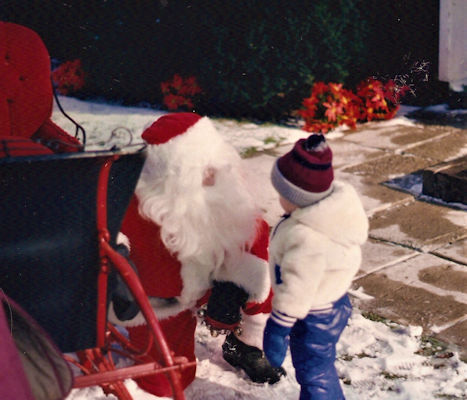
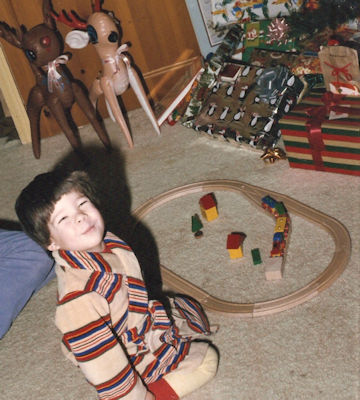
~~~
And now it was time for the next generation – my granddaughter – to choose that ‘one thing’ she wanted from Santa (even though, like the generations before her, many of the other circled items in her book would undoubtedly appear under the tree, too).
As I watched her return to her solemn consideration of the many options available to her (in the end, she would choose the Barbie® 3-in-1 Dream Camper), I couldn’t help but let my mind drift back again across sixty years of Christmases, and all the ways things have changed.
Sometimes, I feel as if Christmas has morphed into a completely different holiday from what it was when I was her age. There’s just so much more of everything – more toys, more choices, more expectations, more celebrations, more lights, more parades, more Santas in more malls. It’s often overwhelming.
But woven throughout those changes are a few things that have, thankfully, remained the same, and been passed down from generation to generation – including our ‘one thing from Santa’ rule.
And, for me, that’s one thing that makes the holidays well worth celebrating.

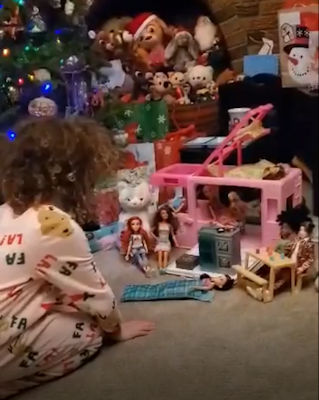
EPILOGUE: My granddaughter brought her Barbie® 3-in-1 Dream Camper with her when she came to my house several days after Christmas for a multi-day/night sleepover. It was great fun for me to pull out some of my ancient Barbies® (yes, I still have them, as well as more than 50 collector Barbies® I’ve accumulated over the years) and get down on the floor to play with her (I gave her a ‘Fantasy Hair Barbie® with Unicorn and Mermaid Looks’ for Christmas) in much the same way Sharon and I played with our Barbies® all those years ago.
And for just a while, I forgot I was on … the other side of 55.
To Review or Not to Review (Part 2)
Product Reviews
Unlike reviews of books, I DO check out product reviews before making most major purchases (i.e., appliances, electronics, or other moderately expensive household items). I tend to focus my research on items that have four stars or above (on sites like Amazon, Home Depot, Best Buy, etc.) and/ or those that are rated ‘Top 10’ or ‘Best Of …’ on consumer reporting sites (like Consumer Reports, Tom’s Guide, CNET, etc.). I base my final purchase decision on a combination of ratings (and comments), features, price, and availability. Generally, I haven’t gone wrong following these protocols.
As for writing product reviews myself – well, I’ve done it a couple of times, but only when prompted to offer my rating and/ or opinion of a product (e.g., by Home Depot). Generally, I use product reviews for my own purposes, but I don’t think about offering my own opinions about something unless I’m really, really happy (or really, really unhappy) with it. I guess, like books, I don’t see how my singular opinion would or should impact someone else’s purchase decision (unless I want to warn them against something, and I’ve only done that once!) Unlike book ratings/ reviews, however, I use product reviews BEFORE I buy, rather than after.
Business Reviews
And, finally, on to the topic of Business Reviews. A lot of people put significant weight on business review sites like Google, Amazon, Facebook, Consumer Reports, Better Business Bureau, Yelp, TripAdvisor, FourSquare, GlassDoor, Houzz, etc. (and/or reviews posted on the websites or Facebook pages of individual businesses or brands).
According to BrightLocal’s 2020 Local Consumer Review Survey:
- 93% of consumers use the internet to find a local business
- 87% of consumers read online reviews for local businesses
- Only 48% of consumers would consider using a business with fewer than 4 stars
I can’t say I rely exclusively on public reviews before using a company or its products/ services (especially those with very few online reviews) but I do check them in many cases, and I certainly wouldn’t contact a contractor or other business/ professional if they had a significant number of 1 or 2 star ratings and/ or uncomplimentary reviews. In my mind it’s an issue of ‘Buyer Beware’ (i.e., do your research in many different ways and always check claims and / or references).
The big problem with many of the review sites is the idea of ‘fake’ reviews. It’s less of a problem now than it’s been in the past (in 2014 and again in 2017, CBC Marketplace did undercover investigations on fake online testimonials – where people hired themselves out to videotape or write positive reviews for money – and exposed a black market in review writing that brought an end to some of it). But that’s not to say it doesn’t happen – small businesses particularly ‘encourage’ family and friends to write positive reviews for them, and I know of firms (and writers) who host ‘give-aways’ or contests for those who post public reviews (and I would assume they only solicit input from people they trust to write positive reviews). There is really no way to tell if the person providing the review actually used the services of the company or not. So – again – it’s ‘Buyer Beware’ (i.e., do your research and don’t rely on web reviews alone!)
What is apparent is that a lot of businesses depend on online reviews. According to the Harvard Business Review, “As more and more consumers turn to e-commerce rather than in-person shopping, ensuring that these online platforms offer a reliable rating and review system is essential to maintain consumer trust. Unfortunately, recent research suggests that fake reviews are far more common than you might think.” NOTE: this also applies to fake reviews on products; search algorithms on sites like Amazon take ratings into account when showcasing products – so the more four and five-star “fake” ratings a company can include, the higher their product appears in the search results!
The issue of rating/ review validity hit home for me recently when I did some research into a rather sketchy-looking trailer park in the ‘middle of nowhere’ that I passed when I took an ‘alternate’ way home a couple of weeks ago. A quick search turned up 92 Google Reviews for the place, with an average 3.9 star rating. Surprised, I began scrolling through the reviews. Right near the top were 15 one and two-star ratings – all from people with quite a bit to say about the horrific condition of the place. But then I came across an equal number from people who gave it 4 or 5-stars and left comments saying they’d been going there for years and loved it. So – who do you believe? (I certainly wouldn’t book a holiday there, based on the visuals and the number of negative ratings/ comments, but then I’m not a ‘trailer park’ kind of girl!)
In any case, I kept reading and was surprised to find 57 three, four, and five star ratings left by individuals who were identified as a ‘Local Guide’ (most didn’t leave any kind of comment, but the ones who did had kept it short and generic – things like, “Great place to go in the summer”, “Hidden gem”, “Nice people, interesting location”, etc.). This led me to immediately ask, “What (or who, I suppose) is a ‘Local Guide’?” And, “Have they really visited this place?”
Well, it turns out anyone with a Google account can become a ‘Local Guide’ and post Google Reviews (usually for things like restaurants, hotels, tourist attractions, etc.), edit Maps, and a whole lot more. According to Google Local Guides “help visitors navigate your local neighborhood, and experience well-hidden secrets that only a resident would know.” Local guides are “a global community of explorers who share their knowledge, compile reviews, share photos, check facts, edit Google My Business listing information and help maintain the accuracy of Google Maps (and the larger ecosystem of Google features).” NOTE: as far as I could tell, NONE of this requires you to actually live in the area you are supposedly a ‘Local Guide’ for (although you do have to select your locale when you sign up), nor are there any apparent restrictions on how ‘far-flung’ your reviews can be.
Intrigued about the idea of the ‘Local Guide’, I did a quick Google Review search of our favourite brewery farm/ restaurant (a 10 minute drive from home). A significant number of Google ratings and reviews were left by Local Guides. Some were just a starred rating, several included (mostly positive) comments, a couple included photographs (although one or two were straight off the company’s website). There was no requirement for them to indicate when they’d visited, what they’d ordered, etc. so I had to wonder if it was all legit (or what percentage of it might be).
Ultimately, I asked myself, “What’s in it for people to become Local Guides in the first place?” Turns out (of course) there are quite a few incentives. Google Local Guides uses a ‘gamification’ reward system. The more someone contributes and shares, the more points (and rewards) they receive over time. Points and ‘badges’ can be traded with thousands of Google partners (to score points, all you have to do is leave reviews, upload photos, answer questions, make contributions to Google Maps, etc.; to earn badges, you must be more active. ‘Gamification’ refers to encouraging users to participate by providing a ‘hit’ of dopamine when they ‘win’ something, even if it’s nothing of actual monetary value).

What’s concerning to me here is that someone looking at these reviews has no way of knowing if a Local Guide actually visited the locale, ate at the restaurant, etc. I have a sneaking suspicion many merely respond to a ‘prompt’ from Google (Google apparently bases its notification system on the town/ city you select as your location when you sign up) by assigning a rating (X stars) and/ or writing a short, generic review (perhaps based on what others had to say about the place) without ever actually GOING THERE! So – many of these are likely ‘fake’ ratings/ reviews (which doesn’t do the business any harm if they’re positive, but can be quite devastating to a company if they’re not).
And businesses are hard pressed to respond to ‘bad’ reviews without coming across as either defensive or arrogant (and its next-to-impossible to have a really negative review – or bombardment of them – removed from an ‘independent review site’ because there’s no ‘proof’ one way or the other that the reviewer is trying to do harm to your business, or that their comments are lies; basically it’s their word against yours). NOTE: However, if you leave a review on some sites – and are easily identifiable – the company CAN take action (even if they really shouldn’t) – like the hotel that kicked out a woman and her granddaughter because she left a three-star review on Hotels.com shortly after signing in. I guess the caveat here is – if you want to leave a negative review about a place, DON’T use your own name or contact info!
As for me, well, I’ve posted positive Google reviews for a few businesses (the decking company we used in 2017; the realtor who helped us purchase our dream property; our local library; the optical house where I bought my glasses three years ago) and two negative ones (both for insurance companies that provided lousy customer service and lost my business as a result). I’ve posted a couple of reviews on Facebook about local businesses that have proven themselves worthy (and when we encountered a problem at our favourite brew pub, I didn’t diss them publicly – I sent a private message, letting them know.) I’ve never considered doing much more – if I’m really happy with a company, I let them know privately; if I’m really unhappy, I do the same. I’d only consider posting something publicly if I felt my positive review would bring the ‘good’ companies more customers, or warn people about the ‘bad’ ones. NOTE: I admit, I was tempted to sign up to become a Local Guide to see if I could post ratings/ reviews of places I hadn’t visited, but I decided it wasn’t worth my time! I’d love to hear from anyone who’s done it, though!)

So – what’s the bottom line? I guess it’s this – use online ratings and reviews with the same skepticism you would use ‘word of mouth’ from someone you don’t know very well. Take everything you read with the proverbial ‘grain of salt’ and do as much research into products and services as you can. Weigh the results carefully before making decisions. And trust your instincts. That’s the best advice you’ll get from someone who’s on … the other side of 55.

